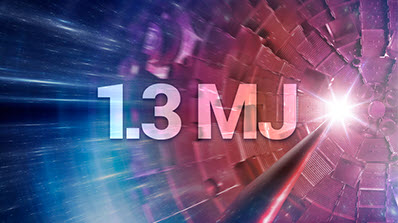On Aug. 8, 2021, an experiment at Lawrence Livermore National Laboratory’s (LLNL’s) National Ignition Facility (NIF) made a significant step toward ignition, achieving a yield of more than 1.3 megajoules (MJ). This advancement puts researchers at the threshold of fusion ignition, an important goal of the NIF, and opens access to a new experimental regime.
The central mission of NIF is to provide experimental insight and data for the science-based Stockpile Stewardship Program of the National Nuclear Security Administration. The experiment was enabled by focusing laser light from NIF — the size of three football fields — onto a target the size of a BB that produces a hot-spot the diameter of a human hair, generating more than 10 quadrillion watts of fusion power in 100 trillionths of a second.
Nevada National Security Site’s Livermore Operations (LO) has been supporting activities at NIF since the early 2000s through diagnostic characterizations, development, and deployment. LO currently has eight active laboratories supporting diagnostic characterizations for instruments that are deployed making measurements in NIF experiments. Characterizations are performed on very complex instrumentation, including a Hardened X-Ray Gated Imager, as well as relatively simple components like optical filters, which are incorporated into larger diagnostic systems. These characterizations ensure the data returned from NIF is accurate and reliable. During its time supporting NIF, LO has deployed as many as 18 field diagnostics technicians to NIF’s Target Area.
“This significant advance was only made possible by the sustained support, dedication and hard work of a very large team over many decades,” said Mark Herrmann, LLNL’s deputy program director for Fundamental Weapons Physics. “This result builds on the work and successes of the entire team, including the people who pursued inertial confinement fusion from the earliest days of our Laboratory. They should also share in the excitement of this success.”
Looking ahead, access to this new experimental regime will inspire new avenues for research and provide the opportunity to benchmark modeling used to understand the proximity to ignition. Plans for repeat experiments are well underway, although it will take several months for them to be executed.

